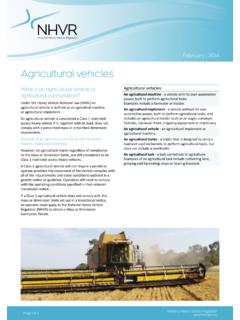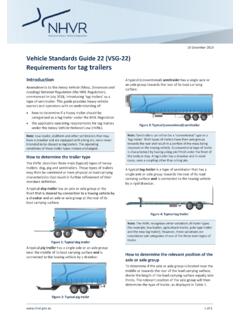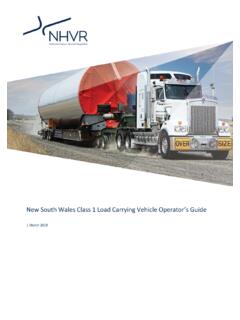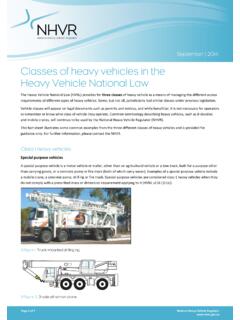Transcription of National heavy vehicle mass and dimension limits - NHVR
1 Page 1 of 10 National heavy vehicle Regulator | 2016 heavy vehicle National LawThe heavy vehicle National Law (HVNL) provides General mass limits (GML), Concessional mass limits (CML) and Higher mass limits (HML) for heavy vehicles operating on the National road network. This fact sheet summarises the conditions for operating general access and restricted access vehicles, relating to axle mass and productivity vehicles, such as B-doubles and HML vehicles are important to the efficiency of the freight task in Australia. The larger capacity of these vehicles also reduces the number of vehicles required to transport a given amount of freight. National heavy vehicle mass and dimension limits IndexGMLG eneral mass LimitsCMLC oncessional mass LimitsHMLH igher mass LimitsHVNLH eavy vehicle National LawGVM/GCMG ross vehicle mass /Gross Combination MassNHVASN ational heavy vehicle Accreditation SchemeNLSNon Load SharingLSLoad SharingPBSP erformance Based Standard S dimensionMeasurement from the front articulation point to the rear overhang lineNational heavy vehicle dimension requirementsThe prescribed dimension requirements for heavy vehicles are set out under the heavy vehicle ( mass , dimension and Loading) National Regulation 2013 (the Regulation).
2 The information contained within this fact sheet has been extracted from the information contained in this fact sheet is accurate at the time of publication and in the unlikely event of any conflict the HVNL document does not cover the authorised access. Some vehicles are not permitted to operate in some states. This document does not cover PBS Vehicles, if you require this information about PBS vehicles, please refer to the PBS Fact 2 of 10 National heavy vehicle Regulator heavy vehicle mass and dimension limits Prescribed dimensionsWidthThe width limit for heavy vehicles is metres, excluding: rear vision mirrors, signalling devices and side-mounted lamps and reflectors anti-skid devices mounted on wheels, central tyre inflation systems, tyre pressure gauges permanently fixed webbing-assembly-type devices, such as curtain-side devices, provided that the maximum distance measured across the body including any part of the devices does not exceed metres.
3 Removable load restraint equipment, if the maximum distance across the body of the heavy vehicle , including any part of the equipment, is not more than height limit for heavy vehicles is metres unless it is a: vehicle built to carry cattle, horses, pigs or sheep - metres vehicle built with at least 2 decks for carrying vehicles - metres double-decker bus - metresLengthFor overall vehicle lengths, refer to the axle mass tables on pages for trailersOn a semitrailer or dog trailer the distance from the front articulation point to the rear over hang line must not be more than metres and the distance from the front articulation point to the rear of the trailer must not be more than maximum forward projection of a semi-trailer, or anything attached to a semi-trailer must not protude beyond a metre arc from the towing pivot pin (King pin).
4 The articulation point to the rear of a semitrailer may be up to metres if the trailer has a distance of not more than metres from the front articulation point to the rear overhang line, does not operate in a B-double or road train combination and otherwise complies dimensionally. Dog trailerExamples Semi trailerPage 3 of 10 National heavy vehicle Regulator heavy vehicle mass and dimension limits Rear overhang and rear overhang lineThe rear overhang of a vehicle is the distance between the rear of the vehicle and the rear overhang line of the a vehicle s rear axle group comprises of only 1 axle, the rear overhang line is the centre-line of that a vehicle s rear axle group comprises of 2 axles, 1 of which is fitted with twice the number of tyres as the other, the rear overhang line is located at one-third the distance between the 2 axles and is closer to the axle with the greater number of a vehicle s rear axle group comprises of 3 or more axles, the rear overhang line is the centre-line of the axle.
5 Any steerable axle is to be disregarded unless the group comprises of only 1 axle and that axle is a steerable axle; or all the axles in the group are steerable axles. Rear overhang on rigid trucksLesser of metres or 60% of wheelbase. Rear overhang on a semi-trailers and dog trailersLesser of metres or 60% of S dimension . Rear overhang on a pig trailerRear overhang on a pig trailer must not exceed the lesser of the length of the load-carrying area, forward of the rear overhang line or 4 of 10 National heavy vehicle Regulator heavy vehicle mass and dimension limits dimensions relating to specific trailer typesLivestock carriers A trailer built to carry cattle, horses, pigs or sheep on two or more partly or completely overlapping decks must not have more than metres of its length available to carry cattle, horses, pigs or sheep.
6 In a B-double built to carry cattle, horses, pigs or sheep, the two semi-trailers must not have more than metres of their combined length available to carry cattle, horses, pigs or - the length available for the carriage of cattle, horses, pigs or sheep on a trailer is measured from the inside of the front wall or door of the trailer to the inside of the rear wall or door of the trailer, with any intervening partitions disregardedRefrigerated van trailersThe front articulation point to the rear of a semi-trailer may be up to metres if the trailer is designed and constructed for the positive control of temperature through the use of refrigerated equipment. Also, the distance from the front articulation point to the rear overhang line of not more than metres does not operate in a B-double or road train combination and otherwise complies dimensionally.
7 Car carriersThe distance measured at right angles between the rear overhang line of a trailer carrying vehicles on more than one deck and the rear of the rearmost vehicle on the trailer must not exceed metres. Axle mass limits comparison tables The mass limits for single axles and axle groups table denotes the GML that applies under the HVNL For CML and HML refer to the tables on pages 6-10. Dog and pig trailers must not be heavier than the truck towing them. The maximum GML for a combination is tonnes unless operating under a notice permit or specific scheme. CML heavy vehicles must be accredited under the NHVAS. HML heavy vehicles must be fitted with road friendly suspension and accredited under the NHVAS. Additional information is available from the HVNL or the NHVR website: disclaimers* heavy vehicles with a GVM over 15 tonnes fitted with specified technologies, including an engine complying with ADR 80/01 (Euro IV), Front Under-run Impact Protection that meets UN ECE Regulation no 93 or ADR 84, and cabin strength that meets the requirements of UN ECE Regulation no 29, are permitted up to tonnes on the steer axle provided it does not exceed the manufacturers rating.
8 Allowable GVM/GCM may then also be increased by up to tonnes.#The type of Road train configurations may vary between the Queensland Class 3 heavy vehicle additional concessional mass limits exemption vehicles may travel on roads throughout Queensland with an additional 250kg on a single front steer axle and an additional 1tonne on a twin steer front axle when operating under a CML Class 3 Notice (to be advised).bSteer axle mass limit can be increased to for a prime mover forming part of a road train fitted with tyres of at least Vehicles may travel on roads throughout Queensland with an additional 3 tonnes above General mass limits , if the maximum mass permitted under GML is > 80 tonnes and an additional 4 tonnes if it is > 120 5 of 10 National heavy vehicle Regulator heavy vehicle mass and dimension limits *, a, b For disclaimer clarification please refer to page 4 Axle/s Axle group/tyresAxle/ vehicle detailsMass limit (tonnes)
9 Single axleSingle tyresSteer axle*, a, bNon steer axle, tyres less than 375mmNon steer axle, tyres 375mm to 449mmNon steer axle, tyres at least axleDual tyresPig trailerAny other vehicle A complying bus, or a bus authorised to carry standing passengers under an Australian road lawAn ultra-low floor bus with no axle groups, only 2 single axle groupSingle tyresNon load-sharing suspension systemLoad-sharing suspension axle groupSingle tyresLess than 375mm375mm to 449mmAt least axle groupDual/single tyresSingle tyres on one axle and dual tyres on the other axle A complying axle groupDual tyresPig trailerAny other groupSingle tyresSingle tyres on all axles with section width less than 375mm, or single tyres on one or two axles and dual tyres on the other axle or axlesPig trailer with either single tyres with at least a 375mm section width, dual tyres on all axles or a combination of those groupDual tyresVehicle other than a pig trailer with either single tyres with at least a 375mm section width, dual tyres on all axles or a combination of those limits for single axles and axle groupsPage 6 of 10 National heavy vehicle Regulator heavy vehicle mass and dimension limits *, a For disclaimer clarification please refer to page 4 Common 2 Axle Rigid TruckType of mass LimitsMaximum Length (metres)Allowable GVM/GCM (tonnes)Single Steer Axle (tonnes)Twin Steer Axle Group (tonnes)Single Axle (tonnes)Tandem Axle Group (tonnes) Triaxle Group (tonnes)
10 *N not not 3 Axle Rigid TruckType of mass LimitsMaximum Length (metres)Allowable GVM/GCM (tonnes)Single Steer Axle (tonnes)Twin Steer Axle Group (tonnes)Single Axle (tonnes)Tandem Axle Group (tonnes) Triaxle Group (tonnes) *N/ *, aN/ 4 Axle Twin Steer Rigid TruckType of mass LimitsMaximum Length (metres)Allowable GVM/GCM (tonnes)Single Steer Axle (tonnes)Twin Steer Axle Group (tonnes)Single Axle (tonnes)Tandem Axle Group (tonnes) Triaxle Group (tonnes) NLS NLS NLS NLS LS NLS NLS LS N/AN/AN/ACommon 2 Axle Rigid Truck and 2 Axle Dog TrailerType of mass LimitsMaximum Length (metres)Allowable GVM/GCM (tonnes)Single Steer Axle (tonnes)Twin Steer Axle Group (tonnes)Single Axle (tonnes)Tandem Axle Group (tonnes) Triaxle Group (tonnes) * per single axleN/AN/ACML not not 7 of 10 National heavy vehicle Regulator heavy vehicle mass and dimension limits *, a For disclaimer clarification please refer to page 4 Common 3 Axle Rigid Truck and 3 Axle Dog TrailerType of mass LimitsMaximum Length (metres)Allowable GVM/GCM (tonnes)Single Steer Axle (tonnes)Twin Steer Axle Group (tonnes)Single Axle (tonnes)Tandem Axle Group (tonnes) Triaxle Group (tonnes) *N/ per tandem axle *, a N/ per tandem axle groupN/AHML not 3 Axle Rigid Truck and 4 Axle Dog Trailer Type of mass LimitsMaximum Length (metres)Allowable GVM/GCM (tonnes)Single Steer Axle (tonnes)Twin Steer Axle Group (tonnes)Single Axle (tonnes)Tandem Axle Group (tonnes) Triaxle Group (tonnes)









